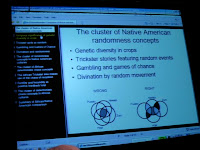
OK, seven below zero Fahrenheit isn't that cold, not for people in Alaska. And it was colder yesterday here and in other spots in town.

The sun was out, but we didn't feel much heat.









 Someone lent me an old 8mm projector and a Copy Kit - a mirror that projects the image onto a plastic screen. Then I'm supposed to video tape the screen. I tried just running the film.
Someone lent me an old 8mm projector and a Copy Kit - a mirror that projects the image onto a plastic screen. Then I'm supposed to video tape the screen. I tried just running the film. But the projector chewed up my 3 foot leader. Then I got some of it to work, but then the film broke. Again the film was being crumpled up somewhere in the process. I mentioned this to a friend the other day who said he had an old projector that probably wouldn't eat the film. So today I went over and interrupted him clearing his driveway and street to borrow it.
But the projector chewed up my 3 foot leader. Then I got some of it to work, but then the film broke. Again the film was being crumpled up somewhere in the process. I mentioned this to a friend the other day who said he had an old projector that probably wouldn't eat the film. So today I went over and interrupted him clearing his driveway and street to borrow it.


"We have entered a new era, the nation has acquired more political oxygen than it has in a long time."I recently talked about how "out-there radicals" stretch the political agenda in my post on Milk. There's been "political oxygen" for the Right since the Reagan election. And since that time 'center' has moved steadily rightward, so much so that many of Richard Nixon's policies would be considered far left today, and they've been doing their best to repeal them - Affirmative Action, Clean Air and Clean Water Acts, for instance.
With Stevens’s Fall, Pipeline for Lobbyists Shuts Off
The article acknowledges that other Senators have done the same thing...
His power made his good will a valuable commodity on K Street, where many lobbying firms are located. During the past five years, just nine lobbyists and firms known primarily for their ties to Mr. Stevens reported over $60 million in lobbyist fees, not including other income for less direct “consulting.” The most recent person to leave his staff to become a lobbyist reported fees of more than $800,000 in just the last 18 months. . .
Mr. Stevens’s preference for one lobbyist over another was big news in industry trade publications, and he did not hesitate to exert his influence. . .
But Mr. Stevens — Alaska’s “Uncle Ted” — is in a class by himself. For most of the last decade he was a dominant voice on both the Senate appropriations and commerce committees, which govern federal spending and business regulation.
 I could get black and white pictures developed in town in a day or two. But there were either 24 or 36 pictures on a roll and it could take days to weeks before I finished a roll. My color slides had to be sent to Hong Kong or Australia to be developed and that took at least two weeks before I could get my pictures back.
I could get black and white pictures developed in town in a day or two. But there were either 24 or 36 pictures on a roll and it could take days to weeks before I finished a roll. My color slides had to be sent to Hong Kong or Australia to be developed and that took at least two weeks before I could get my pictures back. The pictures are digital so you can upload them to your computer, email them, send them on your cell phone. You can enlarge them, crop them, even fiddle with the colors and exposure.
The pictures are digital so you can upload them to your computer, email them, send them on your cell phone. You can enlarge them, crop them, even fiddle with the colors and exposure. 1. What's in those boxes in the basement? Take pictures as you load them up.
1. What's in those boxes in the basement? Take pictures as you load them up. 2. There's a map on the sign, but will you remember the path when you leave the sign? Take the sign with you.
2. There's a map on the sign, but will you remember the path when you leave the sign? Take the sign with you.


 5. Keep track of the information on the for rent signs you pass and what the place looks like.
5. Keep track of the information on the for rent signs you pass and what the place looks like.


 9. Wonder what kind of flower it is? Take a picture then ask someone at a nursery.
9. Wonder what kind of flower it is? Take a picture then ask someone at a nursery. 10. How will I remember all these people I just met and their names? Sometimes you need to ask them to write it in English though too.
10. How will I remember all these people I just met and their names? Sometimes you need to ask them to write it in English though too. 12. I want a copy of this legal document, but they charge $1 a page to print - just take a picture of the computer screen. Also good for your airlines reservations or that I paid my bill on line.(You can do a screen saver too, but not if it's a public computer.)
12. I want a copy of this legal document, but they charge $1 a page to print - just take a picture of the computer screen. Also good for your airlines reservations or that I paid my bill on line.(You can do a screen saver too, but not if it's a public computer.) 13. I really like this camcorder, (jacket, necklace) but I need to check with my wife before buying it. Snap. (get the price tag too.)
13. I really like this camcorder, (jacket, necklace) but I need to check with my wife before buying it. Snap. (get the price tag too.) 14. That's a nice fence, (door, window.) Wonder if I could make/find one like that? Just so I don't forget what it looked like, snap.
14. That's a nice fence, (door, window.) Wonder if I could make/find one like that? Just so I don't forget what it looked like, snap.
 16. Lecture going too fast? Take digital notes.
16. Lecture going too fast? Take digital notes. 17. What's the license plate number of your rental car?
17. What's the license plate number of your rental car? 20. Need to have a copy of a price quote, birth certificate, or passport (or any piece of paper)? Just take a picture.
20. Need to have a copy of a price quote, birth certificate, or passport (or any piece of paper)? Just take a picture.
 But most of the time it was just me and trees and the snow and here, the water.
But most of the time it was just me and trees and the snow and here, the water.













When help is needed, ConocoPhillips employees don't just get their feet wet - they dive in. That's not your typical volunteering and Peter Brakora isn't a typical volunteer.So, non-ConocoPhillips employees don't dive in? I've seen volunteers at a lot of non-profits who give of their hearts to help out. At Covenant House, for example, I've seen Mentors (people working full time and with families) come to monthly mentor meetings, plus they meet with the young adults they are mentoring a couple times a month, plus phone calls. This isn't just getting their feet wet, this IS diving all the way in.
Headquartered in Houston, Texas, the company has approximately 33,600 employees worldwide [from Conoco-Phillips Website]
In 2006, the company matched nearly 3,500 employee gifts for a combined total of $6.1 million.[from Conoco-Phillips Website]So, I started calculating. This would mean that just over 10% of all ConocoPhillips employees participated in this program. Those who participated gave an average of $1743. ($6,100,000/3500 = $1743) What does that mean? Is it a lot? A little? It depends, in part, on how much ConocoPhillips employees get paid. Checking the internet, there are various sites giving us a peek into CP salaries. Payscale.com has salaries that presumably CP employees posted. Theirs is a small sample, and not necessarily all people who posted salaries were actually CP employees or posted their correct salaries. I would guess that people checking out salaries are those earning less than average, but that's just a guess. We also don't know if this is a representative set of salaries or if it skews high or low. But I think this at least gets us in the ballpark. (This is an example of my rambling, because I'm not just giving you a number, but I'm telling you how I got it, and why I'm using it, and raising questions so you can evaluate its validity on your own.)
 I'm also going to assume that people tend to stay at CP if they can, so I'm going to take the 10-19 year median salary of $87,973. A person earning $87,973 contributing $1,743 is contributing just under 2% of her salary. (The regs allow them to contribute up to $6000.)[Or so I thought when I read the website yesterday. This turns out to be related to volunteer time. More on that later.]
I'm also going to assume that people tend to stay at CP if they can, so I'm going to take the 10-19 year median salary of $87,973. A person earning $87,973 contributing $1,743 is contributing just under 2% of her salary. (The regs allow them to contribute up to $6000.)[Or so I thought when I read the website yesterday. This turns out to be related to volunteer time. More on that later.] These eight employees out of a total of about 33,000 employees of CP earned $109,440,405. That's $109 million. (That's eight people making the same amount of money as 1,224 employees making the guestimated 10-19 year employee median of $87,973.)
These eight employees out of a total of about 33,000 employees of CP earned $109,440,405. That's $109 million. (That's eight people making the same amount of money as 1,224 employees making the guestimated 10-19 year employee median of $87,973.)
By volunteering their time, employees in the United States enable organizations to receive up to $6,000 in grants per year from ConocoPhillips to defray costs for programs and events, making a positive and important difference in their communities.Natalie Lowman wasn't exactly sure how much CP gave in such grants in Anchorage, but thought it was around $60,000 for 2008. They could give up to $1500 per employee. When I pointed out that the website said up to $6,000, she said, yes, if there were four employees at one organiztion.
The annual gifts stem from a charter agreement between the oil companies and the state regarding the BP merger with ARCO in the late 1990s. Part of the charter agreement identifies public higher education as a top priority for charitable donations.So, these donations are part of an agreement negotiated so that BP could merge with ARCO in 1999. The Foraker Group Nonprofit Report December 2006 written by the Institute of Social and Economic Research (ISER), University of Alaska Anchorage (pp. 43-44) gives a bit more information on this charter agreement:
In 2006 two of the largest oil companies operating in the state, BP (BP Exploration Alaska, Inc.) and ConocoPhillips contributed a combined total of over $22 million in cash to various Alaska nonprofits, including the University of Alaska, and other organizations such as local governments. Their annual contribution is based upon oil production and price as defined by a Charter Agreement that resulted from the ARCO BP merger in 1999. Some in-kind donations are not included in this total, and some of their donations fund capital expenditures rather than operations.So a minimum amount of contribution is required by this Charter Agreement that was a condition for the BP-ARCO merger. I called Scott Goldsmith, the author of the ISER report, to find out how to get access to the Charter Agreement.He wasn't sure if he ever actually saw a copy, but said he'd check for it tomorrow. [Update: I also called UAA Advancement and later the UA Foundation called and said they would find the Agreement and email it to me .] On the internet, nearly all references I find about BP or ConocoPhillips contributions to the University have that standard clause in them.
Linda Sugin argues in a long article that the tax law should be changed so that charitable deductions are considered business expenses:
There are a few times when I think a corporation should give to charity. The first is if it's not really charity: on the surface, it looks like charity, but so much good will is generated, that it's a win-win...
The second type of charity that I'd support is if a corporation were trying to reverse an earlier wrong. Even without the PR benefit. (For instance, if a record company distributed a CD that advocated cop killing, which is within the first amendment rights, but then someone followed the advice. The corporation may not have acted illegally, but it certainly didn't act responsibly).
Finally, I'd support general charity to whatever organization if the board truly believed that the shareholders wanted to give to these charities.
In fact, there is significant evidence that corporations generally make charitable donations in furtherance of their business--either with respect to their employees, customers, or the communities in which they operate. Most corporate charitable giving can easily fit within the requirements of section 162's deduction for ordinary and necessary business expenses. (p. 8)Corporations, she says later, shouldn't be making charitable donations that don't help the bottom line. When they do it leads to abuse:
Both the popular press and the academic literature are replete with discussion of corporate philanthropy that does more to achieve the private interests of managers than either the public interest, which is the concern of charitable organizations, or the shareholders' interest, which is the concern of corporate governance. (27) The problem seems primarily to be one related to executive compensation; corporate philanthropy that allows managers to support their favorite causes and enjoy the prestige benefits of that support is simply a managerial perquisite. (28)The above quotes are from a business professor.
The Supreme Court's interpretation of "gift" implies something given out of "detached and disinterested generosity." (45) Obviously, a corporation never does anything with feelings of generosity. (46) (p. 8)